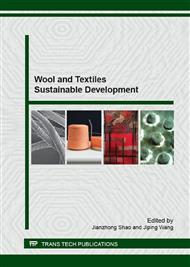p.3
p.9
p.14
p.19
p.25
p.32
p.40
p.46
Effect of Various Chemical Treatments on Handling of Wool Fabric
Abstract:
It is well known that fabric handle is controllable by controlling and adjusting mechanical properties of the fabric. The handling of fabrics, on one hand, is mostly decided by the structure of the fabric, i.e. quality of yarn, yarn count, twist number, density of warp and weft, fabric weight and weave design. Such a fabric structure is represented in terms of Cover Factor. On the other hand, the handling of fabrics can also be changed through the mechanical properties by dyeing and finishing processes after weaving. The present work investigated how much influence is exerted on wool fabric by 11 sorts of chemicals generally used in dyeing and finishing processes, and how much change is exerted on the handle of processed fabrics. The experimental results were compared with the original fabric with no treatment in terms of mechanical properties relevant to KES. It was confirmed that the fabric handle greatly depended on fabric structure. Besides, the differences in the degree of damage and the hydrophilicity of wool fiber arisen from the treatments using chemicals were examined. The effect of chemicals used in dyeing and finishing processes was also investigated on the environment. Keywords: Wool, Chemical treatment, Fabric handle, KES, Environment.
Info:
Periodical:
Pages:
3-8
Citation:
Online since:
November 2015
Authors:
Keywords:
Price:
Сopyright:
© 2016 Trans Tech Publications Ltd. All Rights Reserved
Share:
Citation:


